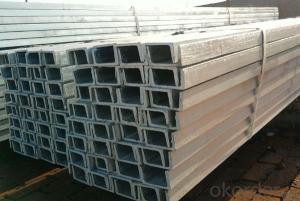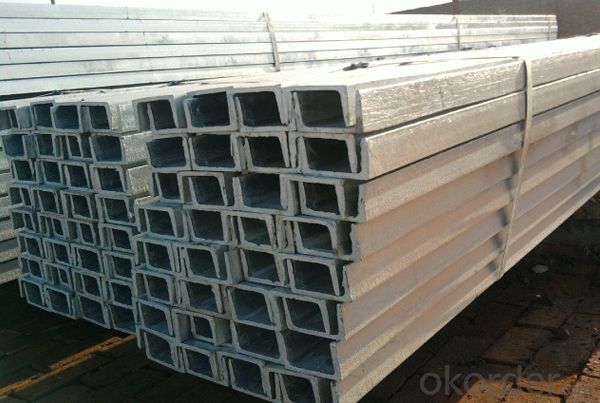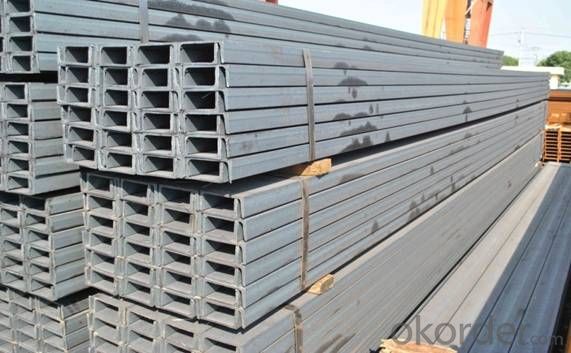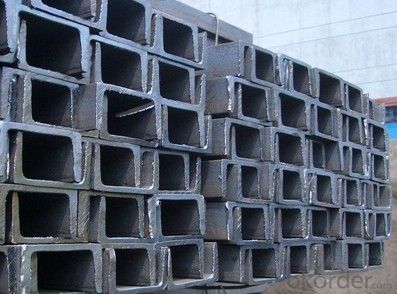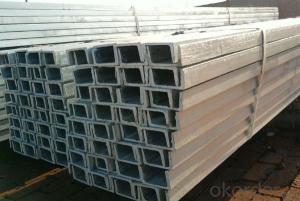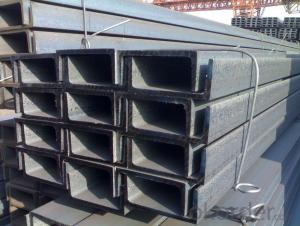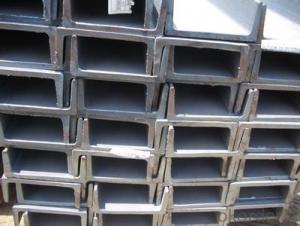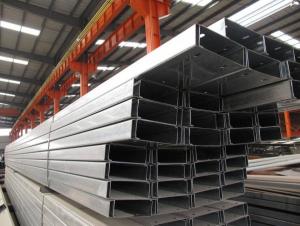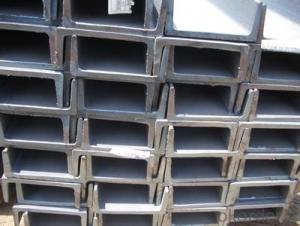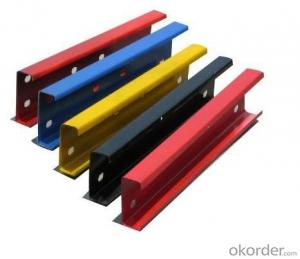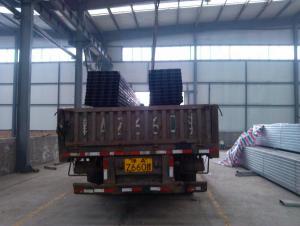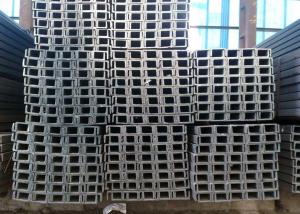High quality hot rolled JIS ou GB U CHANNEL
- Loading Port:
- Shanghai
- Payment Terms:
- TT OR LC
- Min Order Qty:
- 25 m.t.
- Supply Capability:
- 2000000 m.t./month
OKorder Service Pledge
OKorder Financial Service
You Might Also Like
U CHANNEL Details:
Product Description:
Specifications of MS Channel:
1.We supply high quality MS Channel at reasonable price, including Chinese standard, Japanese standard and so on.
Standard | GB/JIS |
Material Grade | Q235,SS400 |
Technique: | Hot Rolled |
Sizes as per chinese standard: | 50*37*4.5mm - 300*89*11.5mm |
Sizes as per japanese standard: | 50*25*3mm – 200*80*7.5mm |
Length: | 6meter, 9meter, 12meter |
Note: 1.we are also competent to provide our customers other MS Channel based on other sizes according to customer’s requirements.
2. The length of our ms channel could be cut into other meters as per customer’s requirements. For example, the channel in 6meters could be cut into 5.8meters in order to be fit in the 20ft container.
2. The detailed sections of MS Channel as per GB standard.are shown in the table-1:
GB U CHANNEL | Standard | Sectional | Dimension |
| Mass: |
(mm) | (mm) | (mm) | (mm) | ||
50X37 | 50 | 37 | 4.50 | 7.0 | 5.438 |
63X40 | 63 | 40 | 4.80 | 7.5 | 6.634 |
80x43 | 80 | 43 | 5.00 | 8.0 | 8.045 |
100x48 | 100 | 48 | 5.30 | 8.5 | 10.007 |
120x53 | 120 | 53 | 5.50 | 9.0 | 12.059 |
140x58 | 140 | 58 | 6.00 | 9.5 | 14.535 |
140x60 | 140 | 60 | 8.00 | 9.5 | 16.733 |
160x63 | 160 | 63 | 6.50 | 10.0 | 17.240 |
160x65 | 160 | 65 | 8.50 | 10.0 | 19.752 |
180x68 | 180 | 68 | 7.00 | 10.5 | 20.174 |
180x70 | 180 | 70 | 9.00 | 10.5 | 23.000 |
200x73 | 200 | 73 | 7.00 | 11.0 | 22.637 |
200x75 | 200 | 75 | 9.00 | 11.0 | 25.777 |
220x77 | 220 | 77 | 7.00 | 11.5 | 24.999 |
220x79 | 220 | 79 | 9.00 | 11.5 | 28.453 |
250x78 | 250 | 78 | 7.00 | 12.0 | 27.410 |
250x80 | 250 | 80 | 9.00 | 12.0 | 31.335 |
250x82 | 250 | 82 | 11.00 | 12.0 | 35.260 |
280x82 | 280 | 82 | 7.50 | 12.5 | 31.427 |
280x84 | 280 | 84 | 9.50 | 12.5 | 35.823 |
280x86 | 280 | 86 | 11.50 | 12.5 | 40.219 |
300x85 | 300 | 85 | 7.50 | 13.5 | 34.463 |
300x87 | 300 | 87 | 9.50 | 13.5 | 39.173 |
300x89 | 300 | 89 | 11.50 | 13.5 | 43.883 |
Table-1
3. The chemical composition of HR Channel Steel according to Q235B is shown in Table-2.
Alloy No | Grade | Element(%) | ||||
C | Mn | S | P | Si | ||
Q235 | B | 0.12-0.20 | 0.3-0.7 | ≦0.045 | ≦0.045 | ≦0.3 |
Table-2
Note: we are able to present our customers relevant SGS test report for chemical composition of HR Channel Steel.
4. The mechanical property of HR Channel Steel according to Q235B is shown in Table-3-1 and Table-3-2
Alloy No | Grade | Yielding Strength Point(Mpa) | |||
Thickness(mm) | |||||
≦16 | >16-40 | >40-60 | >60-100 | ||
≧ | |||||
Q235 | B | 235 | 225 | 215 | 205 |
Table-3-1
Alloy No | Grade | Tensile Strength(Mpa) | Elongation After Fracture(%) | |||
Thickness(mm) | ||||||
≦16 | >16-40 | >40-60 | >60-100 | |||
≧ | ||||||
G235 | B | 375-500 | 26 | 25 | 24 | 23 |
Table-3-2
Note: we are able to present our customers relevant SGS test report for mechanical property of MS Channel as customer’s request.
Applications of MS Channel:
The MS Channel can be applied to construction of warehouses, workshops, sport stadiums and car parks etc.The hot rolled channel steel belongs to carbon structural steel which is applied to in the field of construction and machinery.In details, the hot rolled channel steel is usually used for arch-itechtural structure, and they could be welded in order to support or hang a vari-ety of facilities. They are also usually used in combination with I beam. Generally,the hot rolled channel steel we supply must possess perfect welding property, riveting property and mechanical property and so on.
Package & Delivery of MS Channel:
1.The hot rolled channel steel will be packed in bundle with steel wire at each end of every bundle and color marking in order to help the customer to recognize his goods more easily at sight.
2. And the hot rolled channel steel could be loaded into 20ft or 40ft container, or by bulk cargo.If the weight of each bundle reaches more than 3.5 mt, the loading by break bulk cargo should be choosed.When the weight of each bundle reaches less than 3mt, the loading by container should be choosed.
3.As for the transportaion from mill to loading port, the truck will be usually used. And the maximum quantity for each truck is 40mt.
4.All in all, we could do in accordance with customer's request
- Q: What are the different surface protection techniques for steel channels?
- There are several different surface protection techniques that can be used for steel channels to prevent corrosion and enhance their durability. These techniques include: 1. Galvanization: Galvanizing is a process where a protective zinc coating is applied to the surface of the steel channel. The zinc acts as a sacrificial anode, providing a barrier against corrosion. Galvanized steel channels are highly resistant to rust and can withstand harsh environmental conditions. 2. Powder coating: Powder coating involves applying a dry powder to the surface of the steel channel and then heating it to create a durable and protective finish. This technique provides excellent resistance against corrosion, chemicals, and UV rays, while also offering a wide range of color options. 3. Epoxy coating: Epoxy coatings are commonly used for steel channels that will be exposed to chemicals or harsh environments. This technique involves applying a layer of epoxy resin to the surface, which forms a protective barrier against corrosion, abrasion, and impact. 4. Paint coatings: Painting is a cost-effective surface protection method that involves applying a layer of paint to the steel channel. The paint acts as a barrier, preventing moisture and oxygen from reaching the metal surface, thus reducing the risk of corrosion. Different types of paints, such as acrylic, enamel, or epoxy, can be used depending on the specific requirements. 5. Stainless steel cladding: Stainless steel cladding involves covering the steel channel with a layer of stainless steel. This method provides excellent resistance against corrosion, as stainless steel is highly resistant to rust and oxidation. It also offers a visually appealing and durable finish. 6. Hot-dip coating: Hot-dip coating is a process where the steel channel is immersed in a bath of molten zinc. This technique creates a thick and uniform zinc coating that provides exceptional protection against corrosion. Hot-dip coating is commonly used in outdoor applications where the steel channel may be exposed to moisture, chemicals, or extreme temperatures. Each of these surface protection techniques has its own advantages and suitability for specific applications. The choice of technique depends on factors such as the environment, desired aesthetics, durability requirements, and budget considerations.
- Q: What is the standard length of steel channels?
- The standard length of steel channels can vary depending on the manufacturer and specific requirements but it is commonly available in lengths of 20 feet (6.1 meters) or 40 feet (12.2 meters).
- Q: Can steel channels be used in curved designs?
- Yes, steel channels can be used in curved designs. They can be bent or curved to fit the desired shape, making them suitable for various structural applications that require curved designs.
- Q: What factors should be considered when selecting steel channels?
- To ensure the appropriate choice for the intended application, it is necessary to take several factors into account when selecting steel channels. Firstly, the material grade of the steel channels should be considered. Different grades of steel offer varying levels of strength, durability, and corrosion resistance. The specific requirements of the application, such as load-bearing capacity and exposure to environmental conditions, will determine the suitable material grade. The size and dimensions of the steel channels must align with the project's requirements. This encompasses the height, width, and thickness of the channel, which will determine its load-bearing capacity and structural stability. The shape and design of the steel channels should be chosen based on the specific application and structural requirements. There are various options available, including C-channels, U-channels, and miscellaneous channels. C-channels are commonly used for structural support, while U-channels are often employed for framing and edging purposes. The manufacturing standards and certifications of the steel channels should be carefully considered. Opt for channels that comply with recognized industry standards to ensure their quality, consistency, and suitability for the intended application. The surface finish of the steel channels can impact their appearance, corrosion resistance, and ease of maintenance. Choose between options such as hot-dip galvanized, powder coated, or mill-finished channels. The choice should be based on the project's aesthetic requirements and the level of protection needed against corrosion. Cost-effectiveness is an important factor to evaluate. Compare the prices of different steel channels against their performance, quality, and longevity. Choosing the cheapest option may compromise the long-term performance and durability of the channels. Lastly, consider the reputation and reliability of the supplier. Ensure they have a track record of delivering high-quality steel channels and providing excellent customer support. This includes factors such as on-time delivery, technical expertise, and after-sales service. By considering these factors, one can make an informed decision when selecting steel channels that fulfill the project's requirements in terms of strength, durability, compatibility, and cost-effectiveness.
- Q: Can steel channels be used in staircase construction?
- Yes, steel channels can be used in staircase construction. Steel channels are often used as stringers or supports for staircases. They provide strength and stability to the staircase, making them a popular choice for both residential and commercial buildings. Steel channels are known for their durability and ability to withstand heavy loads, which makes them suitable for staircase construction. Additionally, steel channels can be easily fabricated and customized to fit specific design requirements, allowing for flexibility in staircase design.
- Q: How do steel channels contribute to sustainable design in buildings?
- Steel channels contribute to sustainable design in buildings in several ways. Firstly, steel is a highly durable and long-lasting material, which means that buildings constructed with steel channels have a longer lifespan, reducing the need for frequent renovations or replacements. This results in less waste generation and a lower environmental impact. Secondly, steel is a recyclable material, which means that steel channels can be recycled and reused after the end of their life cycle. This helps to reduce the demand for new steel production and the associated energy consumption and greenhouse gas emissions. Additionally, steel channels allow for efficient and flexible design options, enabling the construction of lighter and more efficient structures. This leads to reduced material consumption, improved energy efficiency, and lower carbon footprint during the construction and operation phases of the building. Furthermore, steel channels are often used in prefabricated construction methods, which can significantly reduce construction waste, minimize on-site disruption, and improve overall construction efficiency. Overall, the use of steel channels in building design contributes to sustainability by promoting durability, recyclability, energy efficiency, and reduced waste generation, making it a preferred choice for sustainable building practices.
- Q: What are the different methods of anti-slip treatment for steel channels?
- When it comes to anti-slip treatment for steel channels, there are various methods available, each with its own advantages and suitability for specific purposes. Some commonly used methods include: 1. Grip tape: This cost-effective solution involves applying adhesive-backed tape with a textured surface onto the steel channel. Grip tape is easy to install and offers good traction, making it ideal for areas with light to moderate foot traffic. 2. Anti-slip coatings: These coatings are specially designed to create a rough surface on the steel channel, enhancing slip resistance. They can be applied using a brush, roller, or spray and are made from materials like epoxy, polyurethane, or acrylic. Anti-slip coatings are durable and able to withstand heavy foot traffic, making them suitable for industrial environments. 3. Perforated plates: These steel plates have small holes punched throughout their surface, allowing liquids to drain through and reducing the risk of slipping. Perforated plates are commonly used in outdoor areas or where liquids are present, such as walkways, platforms, or stair treads. 4. Expanded metal: This type of steel sheet is slit and stretched to create diamond-shaped openings. The raised surface of expanded metal provides excellent anti-slip properties, making it ideal for ramps, stair treads, or catwalks. Additionally, expanded metal is durable and resistant to corrosion, increasing its longevity. 5. Welded serrated grating: This method involves welding serrated bars onto a steel channel, creating a rugged surface that improves traction. Welded serrated grating is commonly used in heavy-duty applications where high slip resistance is necessary, such as oil rigs, power plants, or manufacturing facilities. It is crucial to consider the specific requirements of the steel channel and the intended usage when selecting an anti-slip treatment method. Factors like foot traffic, exposure to liquids, and the need for durability should be taken into account to ensure the chosen method is suitable for the application.
- Q: Can steel channels be used for platform stairs?
- Yes, steel channels can be used for platform stairs. Steel channels are often used in construction for their strength and durability. They provide excellent structural support, making them suitable for stairs and platforms, especially in industrial or commercial settings where heavy loads and frequent use are expected. Steel channels can be easily fabricated and welded to create a sturdy and reliable staircase. Additionally, they can be customized to meet specific design requirements, such as the desired height, width, and angle of the stairs. Overall, steel channels are a popular choice for platform stairs due to their strength, versatility, and ability to withstand heavy foot traffic.
- Q: Are steel channels suitable for load-bearing walls?
- No, steel channels are not typically suitable for load-bearing walls. Load-bearing walls are designed to support the weight of a building or other structural elements, and they require materials with high compressive strength and stability. Steel channels, also known as C-channels or U-channels, are commonly used for non-structural applications such as framing and supporting secondary elements like cladding or drywall. They lack the necessary structural properties to bear heavy loads and may not provide the required stability and rigidity. Load-bearing walls are usually constructed using materials like concrete, masonry, or steel beams that are specifically designed to handle the forces involved in supporting a structure.
- Q: What are the different methods of surface preparation for steel channels?
- There are several methods of surface preparation for steel channels, each serving a specific purpose and achieving different results. Some of the most commonly used methods include: 1. Abrasive blasting: This method involves using high-pressure air or water to propel abrasive particles onto the surface of the steel channels. It effectively removes rust, scale, and other contaminants, leaving a clean and roughened surface ready for further treatment or coating. 2. Chemical cleaning: This method involves using chemicals to remove surface contaminants and oxides from the steel channels. Acid pickling is a common chemical cleaning process, where the channels are immersed in an acid bath to dissolve rust and scale. Alkaline cleaning is another method that uses alkaline solutions to remove organic contaminants. 3. Mechanical cleaning: This method involves using mechanical tools such as wire brushes, scrapers, or sandpaper to physically remove contaminants from the surface of the steel channels. It is often used for smaller areas or localized cleaning requirements. 4. Power tool cleaning: This method involves using power tools such as grinders, sanders, or wire brushes to mechanically clean the surface of the steel channels. It is effective for removing heavy rust, mill scale, and coatings. 5. Solvent cleaning: This method involves using solvents to dissolve and remove contaminants from the surface of the steel channels. It is typically used for light cleaning and degreasing purposes. 6. Water jetting: This method involves using high-pressure water jets to clean the surface of the steel channels. It can effectively remove loose rust, paint, and other debris. It is important to select the appropriate method of surface preparation based on the specific requirements of the steel channels, such as the extent of surface contamination, the desired level of cleanliness, and the type of coating or treatment to be applied. Following the appropriate surface preparation process ensures better adhesion of coatings, improved corrosion resistance, and enhanced overall performance of the steel channels.
Send your message to us
High quality hot rolled JIS ou GB U CHANNEL
- Loading Port:
- Shanghai
- Payment Terms:
- TT OR LC
- Min Order Qty:
- 25 m.t.
- Supply Capability:
- 2000000 m.t./month
OKorder Service Pledge
OKorder Financial Service
Similar products
Hot products
Hot Searches
Related keywords
